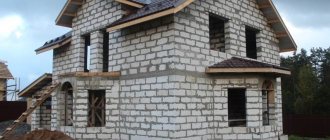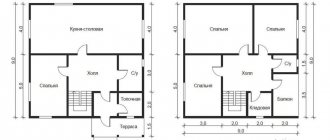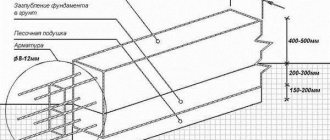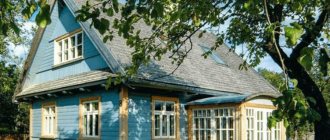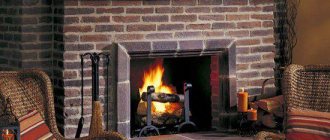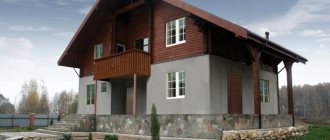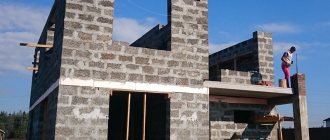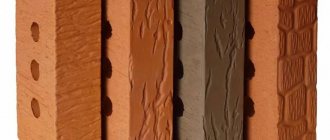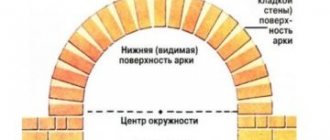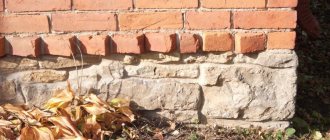Foundation for a two-story brick house.
With the growing level of social well-being and the simultaneous increase in air pollution, many city residents have a need to move outside the city and build their own home there. The most correct choice is a one-story or two-story brick house. This type of house has many advantages.
Foundation depth for a two-story brick house.
In order for a brick house to be of high quality and durable, you need to pay due attention to the foundation.
The service life of brick houses is on average about 100 years; in addition, they are environmentally friendly, resistant to moisture or fire, and resistant to impacts.
But houses don't just sit on bare ground. A house needs a reliable foundation - a foundation. It is, without exaggeration, the most important part of the house and should be even stronger and more durable than the structure itself. With an improperly executed foundation. which may be caused by errors in calculations or savings on building materials, negative consequences for the house will not take long to appear. To complete the foundation, you can contact a construction organization, leave an order and not worry about anything else. But if the budget is limited and you have free time, then you can make the foundation yourself. Next, we will consider the main types of foundations and the procedure for their construction, based on the conditions of the area where construction will take place.
Foundations are divided into 3 types:
House drawing
The second floor of the house usually serves as a place for relaxation
Below you will see an example of a spacious family home with an attic, which contains a competent layout and ergonomic use of every square meter of space. On the ground floor there are all the necessary premises for daily use and comfortable permanent residence:
- technical room (for the boiler room);
- spacious dining room;
- separate kitchen with small pantry;
- bathroom;
- a bedroom that can be used as a guest room or living room.
The basement is finished with stone
The second floor is a living room with three bedrooms and a spacious bathroom. The largest bedroom is intended for the owners of the house; it has a large area, equipped with a separate small room for a dressing room, and access to a balcony. The other two bedrooms are also quite spacious and can be used as children's rooms for younger family members of any age, older people or guests.
Ribbon type of structure.
Strip foundation diagram.
A strip foundation is a wall made of durable material sunk into the ground to transfer the weight of the main building to the ground.
The strip foundation, in accordance with its name, resembles a strip in appearance, is a wall made of durable material sunk into the ground to transfer the weight of the main building to the ground. The shape of the strip foundation must correspond to the design of the house and pass under all its load-bearing walls. It must withstand the wall of a two-story, and even more so a one-story house without deformation.
In turn, the strip foundation according to the method of execution is divided into 2 types:
House with garage
They say that “a house is formed from its parts.” There are a number of elements that help shape the overall look of a home, and each part contributes to the curb appeal. Therefore, any part of the house is important, garage doors are no exception. If you have a garage, consider the color of its doors.
The color of the garage door is in harmony with the color of the second floor cladding
Garage doors look like one of the features of the house. Being the largest entrance to the house, they include almost a third of the house. They are usually given little attention - they are a prominent part that requires careful thought and attention from a design perspective because it creates an aesthetic impact that contributes to overall appeal and value.
One-story house with garage and terrace
Choosing the right color for your garage door is also important because it affects the character of your home in so many ways. It gives positive curb appeal, reveals your personality, and can make a home stand out from the rest.
Gothic house with garage
Monolithic foundation.
Monolithic foundation for a two-story brick house.
A monolithic foundation is erected by filling the pit with the selected building material.
A monolithic foundation is erected directly on the construction site by filling the pit with the building material selected for the given soil. The following types of material are used to fill a monolithic foundation:
- Rubble concrete (pouring using coarse filler - broken brick, concrete, gravel).
- Reinforced concrete (pouring using steel reinforcement and crushed stone).
- Brick (clay brick masonry).
The process of constructing a monolithic strip foundation is quite simple and consists of the following steps:
- Digging a foundation pit according to the house plan.
- Filling and compacting the sand cushion.
- Installation of formwork.
- Installation of reinforcement cage (for reinforced concrete foundation).
- Filling the formwork with the selected concrete.
Video description
See the video for several architectural projects of one-story houses:
Two-story house 10x12 with a balcony and an open terrace Source catalog-plans.ru
House 10x12 with attic floor Source sitysun.ru
One-story house 10x12 Source kreddo.ru
House 10x12 with attic, balcony and garage in the basement Source pinterest.ie
Formwork for installation.
Foundation formwork for a two-story brick house.
The formwork must be constructed so that it can be installed and removed easily without damaging the foundation.
Some tips for installing formwork, since the quality of the resulting foundation largely depends on its quality. The formwork should be easy to install and just as easy to remove, so as not to damage the finished foundation. Its strength must ensure that it maintains the shape specified by the design. Wooden or steel materials are used to make formwork. For wooden formwork, waterproof plywood, particle board or fiberboard and dry coniferous wood are used, the boards of which must be smoothly planed and have a width of no more than 15 cm. Plywood, fiberboard and chipboard are good to use in the manufacture of curved sections of the foundation. Metal formwork has special fastenings, is easy to assemble, durable and easy to dismantle. You can buy it, or better yet try to rent it.
The reinforcement makes the foundation structure stronger and more flexible, and provides a certain margin of safety in the event of an increase in the weight of the residential part of the house. The reinforcement frame is assembled in parts from ready-made spatial fragments, manufactured in advance according to the foundation design. Each laid fragment should not interfere with the laying of the next one. As they are laid, the fragments are fixed and welded together until a single monolithic structure is obtained. After laying the last section, the readiness of the reinforcement frame with formwork is checked and the pouring of the foundation begins.
Features of the layout of bedrooms and children's rooms
Despite the fact that residents of a 10x12 house will spend most of their time in common areas, such as the living room and kitchen, it is necessary to take a very responsible approach to the organization of bedrooms and children's rooms.
A 10x12 house is large enough to accommodate a spacious children's room Source dom-steny.ru
It is here that a person will fall asleep and wake up, and children will play in their rooms, do school homework, and therefore their mood and well-being throughout the day will depend on their proper organization. The basic rules for arranging children's and bedrooms can be called:
- orientation of windows to the south or east, as this will allow more frequent penetration of natural light in greater quantities;
- location of the bedroom in a quieter place, for example, in the back of the house or on the second floor, then the rest will be more relaxing;
- meeting or exceeding the minimum permissible room dimensions. To comfortably accommodate one person, a minimum of 8 square meters is required, so a bedroom for two people should be at least 16 square meters. m. A children's room, which is filled with a sufficiently large amount of furniture and other items, should not be cramped and, among other things, have a sufficiently large space for games;
- lack of passage through the room to another room of the house;
- the minimum height from floor to ceiling should be no less than 2.5 meters;
A ceiling height of 2.5 meters is enough even to accommodate sports equipment Source bankfs.ru
- The shape of the rooms in plan should be either square or rectangular, but its length should not be much greater than the width.
Since most often rest rooms and children's rooms are located on the second or attic floor, and the delimiting structures are not load-bearing walls, it is best to arrange the furniture during the preparation of the project and only after that accurately indicate the location of the internal structures.
See also: Catalog of companies that specialize in designing country houses.
Prefabricated option.
Prefabricated foundation for a two-story brick house.
The prefabricated foundation is installed on sand pads made from ready-made factory concrete blocks.
The prefabricated foundation is somewhat reminiscent of a Lego set. All you need to do is dig a hole for the foundation and prepare a sand bed. Such a foundation is assembled from individual reinforced concrete blocks, which are made to order in a factory. Making such a foundation significantly reduces the time and effort that needs to be spent on work. The finished fragments are installed one on top of the other and fastened with cement mortar. At the same time, the manufacture, delivery and installation of prefabricated parts using a truck crane makes the project more expensive and reduces the strength of the foundation, since it cannot be monolithic.
Townhouse with pool
To ensure that your townhouse is not just a beautiful and cozy place, but also a place where you can relax, we recommend building it together with a swimming pool.
- Decide right away where the place for relaxation will be built, look at photos of brick options with examples. The pool inside will be more practical, because it can be located literally in the next room. At the same time, with a swimming pool on the territory, your site will look even more beautiful and richer.
- When thinking about how the entire building will look, think about the cladding of the house. Please note that it is recommended to decorate the cottage and relaxation area in the same style.
- For example, you can decorate a house with yellow brick, and the “beach” area with yellow, gray low-porosity clinker.
- The facade can be made of gray material, and the area around the pool can be decorated with artificial stone.
- If the facade is dark green, then the pool area is best decorated in white, gray and even black colors. By adding various plants and statues here, you will get not just a pool, but a whole mini-garden with a personal pond.
- Why, in this case, will brick be a suitable material for building a house and cladding a relaxation area? Because this material has good characteristics: the home will be warm, it will not get damp, the pool area will be safe, since the low-porosity clinker will provide the required level of water absorption.
Bored piles.
Pile foundation for a two-story brick house.
A pile foundation is used in unstable soil, as well as in areas prone to flooding. This foundation is considered one of the most economical options.
Pile foundations are used for construction on very unstable soil, in areas subject to flooding, or in order to save construction budget. When building on unstable ground, the job of the piles is to penetrate through it and secure itself to the solid foundation underneath. Today, using this technology, skyscrapers are literally built in swamps. If the site is located next to a river or lake that periodically overflows its banks, the height of the piles above the ground is set based on the known maximum level of water rise. As for efficiency, the benefits are obvious. Piles are installed only under load-bearing walls and columns, if they are provided for in the project. The essence of such a foundation is that piles placed in the ground are connected to each other by horizontal beams - grillages, and the slab of the first floor of a brick house is installed on this structure. Piles can be divided into 5 types, according to which they are installed.
The first 3 types listed require the use of special heavy equipment, but since we are talking about independent work, prefabricated and cast-in-place piles will be considered in more detail.
We build a pile foundation with our own hands. To equip prefabricated piles, square holes are dug at a distance of 1.5-2 m under the load-bearing walls, 30 cm deeper than the foundation will be laid. A mixture of gravel and coarse sand is poured into a thick layer onto the bottom of the pit, insulated with film, it is compacted, and a reinforcement pin or thin steel pipe is driven into the bottom of the pit to give strength to the masonry. Then a pillar of solid brick is laid on cement mortar. After the masonry has hardened, it is waterproofed and covered with soil, which is constantly compacted as it is added.
Strip pile foundation for a two-story brick house.
You can also use a combination of strip and pile foundations. This is very common for the construction of brick houses.
A much less labor-intensive method is to install cast-in-place piles. The technology is as follows: along the perimeter of the building and along the line of load-bearing walls and columns, wells are drilled to the required depth using a manual or motorized drill, the bottom of which is isolated with sand. Next, a pipe made of 1-2 layers of roofing material is inserted into the well, thereby insulating the pile from moisture. After this, a frame of reinforcement 30 cm above the future pile is inserted into the well for attachment to the grillage. During subsequent pouring, every subsequent 40-50 cm of concrete must be exposed to a vibrator to get rid of air bubbles. When the last pile hardens, they are leveled horizontally with cement mortar and a monolithic grillage is installed using the strip foundation construction technology described above. After hardening, the upper surface of the foundation is leveled with cement-sand mortar and insulated with one of the selected materials. The foundation is ready for installation of floor slabs.
Monolithic slab.
Slab foundation for a two-story brick house.
A slab foundation is a monolithic concrete slab measuring 30-50 cm. This type of foundation is considered the most durable.
Slab foundations are used on soft soils. It is a thick monolithic reinforced concrete slab 30-50 cm thick on which the house rests. Its advantages include the reliability of the design. With such a foundation, a brick house has low pressure on the ground and is practically independent of changes in the condition of the soil underneath it. The downside, which does not affect the quality, is the high consumption of material and labor, which in turn increases the cost of the work. This type of foundation, despite the significant amount of work, is made quite simply.
First of all, a pit is torn off, its bottom is leveled, covered with a layer of sand up to 30 cm, which is carefully compacted. If the future brick house is planned to be equipped with bathrooms, pipes for water supply and sewerage are installed. Then a thin, up to 10 cm, screed made of sand-cement mixture is poured. After hardening, a layer of waterproofing and, if desired, thermal insulation is laid on it. Then a metal frame made of reinforcing mesh is mounted on this sandwich. The next step is the installation of very durable and reliable formwork. Finally, concrete is poured into the prepared form, leveled and cured for a month.
House facade color
Brick is used in a variety of home styles, including traditional and modern, and it looks great when accenting homes with paint. Brick comes in a variety of styles and shades, including neutral white and more dramatic red. And even within the same type, bricks vary in color from one to another. Based on this, determine the paint color that will be included in the scheme.
Yellow doors are a warm, rich accent in the composition
A basic rule of thumb is that brick facades look best with a combination of three colors. This gives a good balance between the two: the first main one creates the overall color and background and the other two add a little contrast to make the look richer.
Delicate light shades look very elegant
Main color
The base color is applied directly to the walls - a nice rich tone that you can live with for a long time. This color usually requires a large financial investment, so it makes sense to buy paint that will last a long time.
You can completely change the look with a good neutral base color by changing accents in places like the front door or shutters.
Dark colors visually reduce the size of the house
Think before you decide to paint: your home typically has a mature color that has stood the test of time and is unlikely to go out of style any time soon. If you are determined to paint your brick house, be sure to take into account the architecture of the building and neighboring buildings.
Ideally, for a house to fit into its surroundings, it should be made in a similar color scheme to its neighbors.
Advice Regarding architecture, do not forget the simple rule that dark colors will visually make the house smaller, and will also attract more heat into the house due to the ability of dark colors to attract sunlight.
Light colors make the house visually larger and do not create a thermal effect.
Light colors do not create a thermal effect
Secondary color
Secondary color is often found as stonework on the front façade, this can be:
- feldspar;
- tiles;
- brick.
A secondary color can also be used to decorate the house:
- cornices;
- gutters;
- window;
- frames;
- hedge
If there is not a lot of stone, it will look like an “almost neutral”, secondary color. On some homes, a trim paint color that matches the stone will look good, which can also work as a reclaimed stone. This grouping of secondary colors should not take up a large area of the front of the house, because otherwise it will create the effect of the stone competing with the main color of the house, when you should have more neutral color as an accent color.
This color does a great job of breaking up the front of the house visually, highlighting the architecture (like windows, gables, flower beds and porches) and giving some depth or balance to a home that can sometimes look like a big, flat rectangle. In most cases, you want a lot of contrast between the primary and secondary colors.
The entrance is decorated with decorative stone cladding
Accent color
A bright, bold color may be appropriate for the front door, but will be a little out of place for an entire home that includes a third color, an accent color. This is a bit of a bold zone, choose something that expresses you if you want. This can also be a place to finally show some personality in outer colors or simply use color to evoke some feeling.
The accent color doesn't have to be a bright red door that announces your style to everyone who passes by, but it could be a deep charcoal gray paint on the shutters or a soft buttery yellow on the porch floor.
This is the place to create some style.
Entrance door in contrasting white
There is a design theory that the ideal ratio of these 3 colors should create a 60:30:10 ratio. Which corresponds to the primary, secondary and accent color respectively. Use this ratio to achieve harmony.
Ideal ratio of 3 colors
So, to use this information with a brick facade, you will need to use brick as one of the three colors. Depending on the amount of brick, this will most likely be a primary or secondary color (perhaps combined with another secondary color).
Brick base color
Matching colors
While brick tone varies greatly, some of the favorite traditional accent colors include:
- Yellow plus cream.
- Charcoal plus light grey.
- Sage green plus dark grey.
- Plum plus cream or taupe.
- Decorative wood finish and medium red color.
- Rich green plus grey.
- Cool gray plus cool green.
- Forest green plus black.
Whitewashed walls and blue accents on windows and doors
Elements that are part of your home will also become part of your color scheme. For example, the roof is a dominant element which, depending on the color, can be a key factor in choosing the rest of the palette. A red brick house with a black roof already establishes two primary colors.
The walls and roof are the same color and contrasting white on the windows and balcony
Some brick houses have a facade that includes another material - plaster, for example. This way the brick can hold less color dominance . The landscape will ultimately determine how your color scheme looks: lots of colors may call for a more neutral palette, while an all-green yard will offset the house by incorporating bright hues.
House in black and white colors
Features of the bookmark.
When planning the construction of a brick house, it is necessary to study in detail and strictly observe the following rules:
- The soil on which construction is carried out can be very diverse, and each has its own type of foundation.
- The lower edge of the foundation should always be 20-25 cm below the soil freezing level.
- Groundwater has a negative impact on the condition of the foundation, so during construction measures should be planned to combat it.
- During construction, use only high-quality materials.
- Carefully follow all construction technologies and safety measures.
A correctly selected, designed and manufactured foundation will allow a house built on it to stand for decades and serve many generations of its residents.
Strip foundation for a two-story brick house.
The duration of trouble-free operation of a residential building largely determines the quality of the supporting structure. A two-story brick building has significant weight, so increased demands are placed on its foundation. We will consider in detail what types of foundations are suitable for the construction of private brick houses, the procedure for calculating parameters and the main stages of construction.
Foundation depth for a two-story private brick house.
Zoning
For small, beautiful two-story buildings, this stage of work is relevant. It happens when the common living area cannot accommodate the necessary interior elements. In this case, a zoning technique is used, which consists of combining several work areas in a single room. You can combine two separate options, for example, a kitchen and a guest room, but it is not advisable to do this with a bathroom. If there is not enough space for a dressing room, music studio or home office, you can combine such options with a bedroom. Selecting interior elements so that the space does not look cluttered is an art. Therefore, sometimes you have to turn to professional designers for help, who, in accordance with the house plan, will help you design the areas of a two-story building with minimal space consumption.
Types of supporting structures for a private 2-story house.
The massiveness of two-story brick buildings implies the presence of a supporting structure of increased rigidity. These include:
- strip foundation;
- monolithic slab;
- a combined option, when the base of the strip foundation is reinforced with pillars.
It makes no sense to consider a pile foundation as a supporting foundation for a two-story brick house due to its instability. Screw piles will successfully cope with their function under a one-story building or if timber is used for the construction of walls.
Comment! The purpose of the support pillars when arranging a strip foundation for a two-story house is to strengthen the strength of the foundation when it is placed in a swampy area or on moving soils.
Foundation formwork for a two-story brick cottage.
Due to its capabilities, the best option for placing a two-story building is a strip foundation. It ensures uniform pressure distribution of load-bearing walls and partitions, be it brick or foam concrete, and is cheaper than a monolithic slab. In order for the structure to cope with the task, a competent calculation of loads is required to determine the depth and width of the tape. The complexity of the construction process is mitigated by the ability to complete the work without the involvement of a specialized team.
A monolithic foundation is characterized by increased reliability, which is important when constructing a brick building. But its cost is incomparably higher than the tape type. A significant limitation for wide distribution is the impossibility of arrangement on one’s own.
Factors determining the type and size of the foundation.
The final choice in favor of one type of support structure or another is made after analyzing a combination of factors; the following points deserve attention:
- Information about the geological condition of the site. This includes the soil’s tendency to heave, groundwater level, freezing depth and other characteristics of the site.
- Characteristics of building materials. from which it is planned to build a two-story house. For example, the mass of a two-story house made of foam blocks is incomparably less than a similar building made of brick. The type of floor, roof design, and type of finishing materials matter.
- Presence of additional loads. This takes into account the weight of the planned equipment, furniture, and the mass of snow cover on the roof.
- Financing opportunities.
Foundation depth for a two-story brick house.
In addition to all the listed indicators, the estimated pressure of the foundation that it will exert on the soil is taken into account. The data obtained is compared with standards developed for various types of soil, and a choice is made in favor of the optimal option. As a rule, a strip foundation for a two-story brick house is the most acceptable solution.
To calculate the bearing capacity of the strip base, it is necessary to determine the height and thickness of the structure. With soil freezing rates in different regions ranging from 1.0 to 1.8 m, the average depth is 1.5 m. The information specified in SNiPs and data from the geological bureau of a particular area will help you make calculations.
Important! The calculated indicators indicate the minimum acceptable parameters of the strip foundation. In practice, it is recommended to add at least another 10 cm to the obtained values.
The main stages of arranging a strip foundation.
It is better to entrust the design of a strip foundation for a two-story building to a specialized company. After marking the site according to the existing plan, they proceed to earthworks.
Cushion and formwork.
You can dig a trench for the construction of a two-story cottage using an excavator or manually. In the first case, it is difficult to achieve the required indicators for arranging a strip foundation, in the second, the process will take a lot of effort and time. The trench is prepared with a reserve depth for adding crushed stone to the cushion.
The bottom is compacted manually or using vibrating plates. With a mass of 1.2 kg, 10 passes are enough to compact the base and avoid further subsidence of a two-story brick building.
The strip foundation cushion is made from various materials:
- Sand. To ensure high-quality compaction of the sand layer, it is first watered with water. The approximate thickness of the layer is 20 cm.
- Suitable crushed stone fraction is from 20 to 40 mm. It also needs compaction. Sometimes it is mixed with sand for this purpose.
- A concrete base is the most reliable foundation for a two-story brick house. Initially, a 10-centimeter layer of crushed stone is poured under the future strip foundation, then formwork is formed and concrete is poured. The use of reinforcement increases the strength of the concrete pad.
Comment! The size of the pillow exceeds the width of the strip foundation on both sides by 15-20 cm. Its thickness is guided by the groundwater level and ranges from 20 to 80 cm. Waterproofing is designed to protect the lower part of the strip foundation from moisture.
Foundation depth for a two-story brick cottage.
Formwork can be removable or stationary. The removable version is divided into disposable and reusable. The disposable used frame, after the strip foundation has been poured and hardened, is disassembled and spent on other household needs when arranging a two-story brick cottage. It is not profitable to purchase reusable formwork for private use; it is better to rent. Stationary formwork has many advantages - quick assembly, attractive appearance of the strip foundation. But its cost is much higher than the usual plank construction.
Foundation depth for a two-story private brick house.
If the construction of a two-story cottage made of brick is carried out on soil with poor moisture permeability, it is recommended to provide drainage for the strip foundation. This includes:
- drainage pipes;
- inspection wells;
- water intake
The pipes are placed along the outer perimeter of the future two-story building at a distance of 1 m. The laying depth is below the base of the strip support structure. The approximate width of the trench is 30 cm.
Basic steps for arranging drainage:
- The bottom of the trench is covered with geotextile.
- A layer of fine crushed stone (about 10 cm) is poured on top.
- The installation of pipes is carried out with a slope of 5% towards the drainage basin.
- A 10 cm crushed stone layer is also formed on top.
- Everything is covered with geotextile edges.
- Finally, coarse sand or crushed stone is poured in.
Such protective measures help preserve the integrity of the strip foundation for a long time and extend the life of a two-story brick building.
Foundation depth for a two-story private cottage made of brick.
Reinforcement and filling.
The role of reinforcement is to increase the strength of the strip base, because a two-story brick building requires a reinforced foundation. In addition to standard metal rods, it is worth considering an improved version of rods for the frame of a strip support for a two-story building. Manufacturers offer stainless steel reinforcement made from basalt fiber. The set of advantages and disadvantages of composite material makes the issue of its use in the construction of a heavy brick house controversial. Everything is decided on an individual basis. Typically, ribbed metal rods with a diameter of 12 or 14 mm are used to reinforce the strip support structure. Describes in detail the requirements for the arrangement of a strip concrete foundation SNiP 52-01-2003.
Advice! The frame is installed using viscous wire; the use of welding is undesirable due to the risk of damage to the integrity of the structure.
Foundation formwork for a two-story private house made of brick.
Concrete is poured into the formwork to form a strip foundation in one step. Interrupting the process will significantly reduce the strength of the foundation of a two-story brick cottage. Ordering a concrete mixer will significantly facilitate the labor-intensive process, but you must first make an accurate calculation of the need for concrete solution.
Deep vibrators will help eliminate air bubbles and avoid dangerous voids. After pouring, the strip foundation is left to harden. The minimum period is about a month. At high temperatures it is periodically moistened. Covering the strip foundation with polyethylene will help slow down the process of moisture evaporation and ensure uniform drying.
Foundation depth for a two-story brick cottage.
Which foundation is better for a two-story brick house?
The foundation is the basis of any capital construction, so before you begin choosing the type of foundation, you should determine several important factors related to both the soil and future loads. If you intend to build a two-story brick house, first of all, you need to do some research.
To ensure that the foundation does not sag, crack, or become distorted over time, it is necessary to order geotechnical studies. At this stage, specialists take soil samples, identify their quality characteristics, and, based on the research conducted, will provide a report and recommendations on which foundation is best for a two-story brick house.
Foundation depth for a two-story brick house.
A mandatory criterion for deciding the type of foundation should be the general load indicator, which carries a large number of indicators related to the weight of all structures and payload. Such values are also very important in order to determine the total area of the foundation. Laying a foundation for a house is a delicate matter. The foundation for a two-story house should not be too large, as this will increase its cost.
What type of foundation is better for a two-story brick house?
For two-story houses, experts recommend choosing a strip foundation. Strip foundations can be shallow or deep.
The choice of foundation type is influenced by the following factors: the weight of the building structures, the type of soil, the groundwater level and the depth of soil freezing. Taking into account all these factors, experts determine the required type of foundation and its dimensions. A visual diagram showing the basic principles of laying a strip foundation for a brick house.
For brick houses it is necessary to install deep strip foundations.
Image of a recessed strip foundation:
Foundation depth for a two-story private cottage made of brick.
A visual diagram of a strip foundation shows what basic components this type of structure consists of.
Foundation depth for a two-story private cottage made of brick.
To build a quality foundation yourself, you will need:
- compact the bottom of the trench well, which is also the foundation of the future foundation;
- make an underlying layer of crushed stone, compact it well into the ground;
- make a sand cushion;
- compact the sand cushion well;
— install formwork corresponding to the dimensions of the future foundation;
— install the reinforcement cage;
We do not recommend choosing slab foundations for two-story houses. Such foundations are not strong and stable. They are designed for small garage-type buildings. Buildings of two or more floors need reliable strengthening from below.
